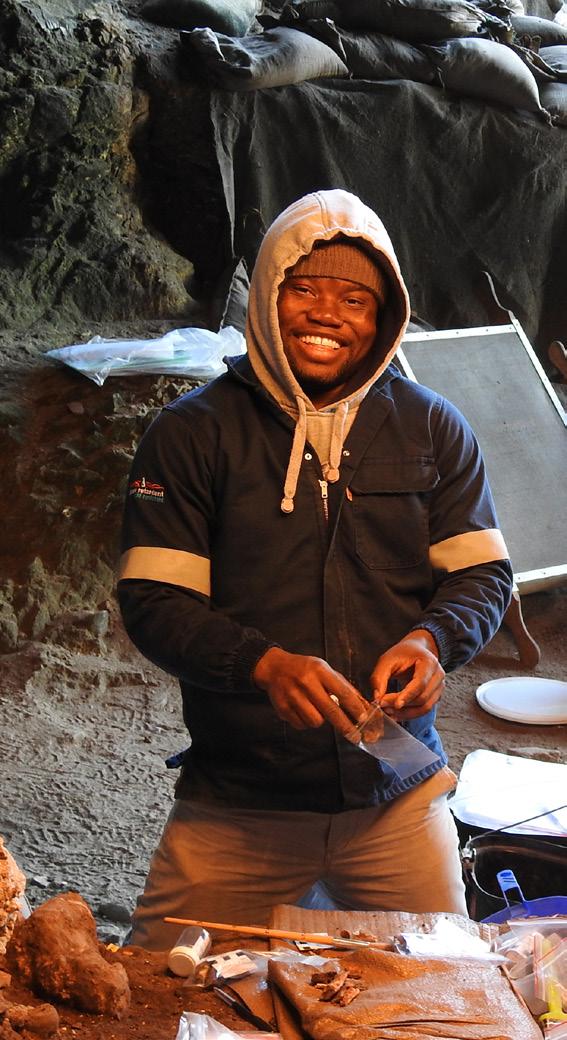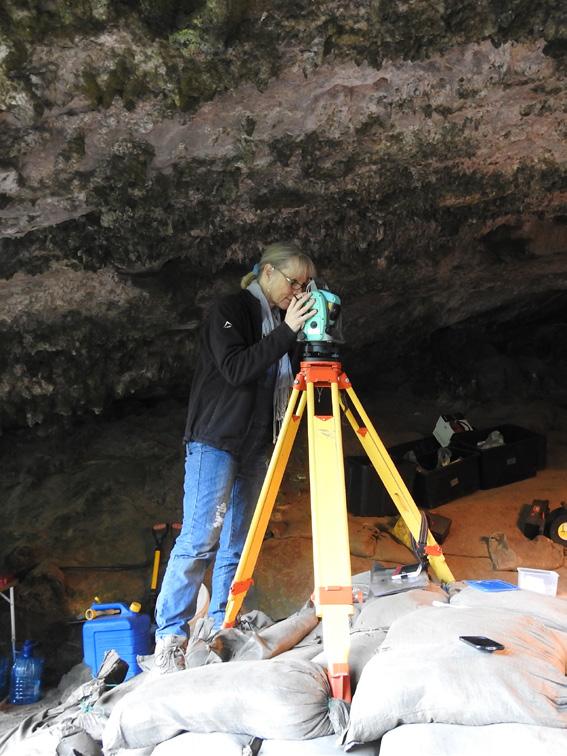
4 minute read
Hot stuff from Klasies River main site
Overview of Klasies River main site
Klasies River main site, situated on the picturesque Tsitsikamma coast of the south eastern Cape coast, provides unique insights into the long history of Homo sapiens. The site contains 21 metres of well-preserved hunter-fisher-gatherer archaeological remains dating to between 120 000 and 45 000 and also 23 000 to 4800 years ago. At present the remains of more than 50 humans who lived at this site during this time period have been excavated. The dense shell middens, stone and bone tools and many hearths provide glimpses into the behavioural and cognitive characteristics of our ancient ancestors. This year no excavations took place and the focus has been on consolidation and publishing new data.
Analysis of fire related phenomena played an important role in this year’s publications as excavations and microscopic analysis revealed unexpected finds. One example is the reddened and fractured quartzite fragments found at Klasies River from the 2015 season onwards. Reddening and fracturing of rocks are generally associated with the use of stones in cooking or as hearthstones around the fire. However, since neither hearthstones nor hot-rock cooking were previously found in Middle Stone Age contexts, we conducted a series of experiments to understand how these reddened fractures rocks formed. Silje Evjenth Bentsen explains the experiments on page 36-37. These results were published in the Journal of Field Archaeology in 2019.
But what can heated rocks and fire use tell us about the humans staying at Klasies River? We see that there are different types of fire use at the site. Firstly, there are remains of very small fires. Little time was needed to gather firewood or otherwise prepare for these fires, but they would have died down quite quickly and represent short use. Secondly, there are remains of slightly larger fires, which required more wood and preparations and could be used for longer or by more people. Lastly, the reddened quartzite indicates that people had used time to gather quartzite before starting the fires. The quartzite was heated repeatedly to high temperatures and much firewood was required for these fires. These different types of fire use indicate that people used Klasies River in different ways, from short stays that might just represent an afternoon to longer stays of days or perhaps even weeks. We presented these ideas in 2019 in a book chapter in the book “Architectures of Fire: Processes, Space and Agency in Pyrotechnologies”, edited by Dragoş Gheorghiu (Archaeopress).
Another study of hearths dating to between 120 000 and 65 000 years ago revealed that people from Klasies River roasted starchy foods such as roots and tubers. A scanning electron microscopic study of the ashes revealed plant tissue or parenchyma that indicated heating of such foods. This paper, published in Journal of Human Evolution, showed that roots and tubers definitely formed part of the Klasies people’s diet, and that they had the foresight to roast these foods, making it more digestible – so much for the idea that the “paleodiet” consisted mostly of protein and fat! We also undertook a detailed investigation of lithic implements from the layers containing the heated quartzite blocks. The lithics are also made from quartzite, and the cobbles from which they were made were not heated. In a paper published in Journal of Archaeological Science Reports, we showed that the knappers were masters of their trade, and that they manipulated oval shaped cobbles to obtain expertly designed points and blades that were further used to process animals, plants, shellfish and fish.
All of these investigations focused on the Middle Stone Age, but an experimental study of a dual holed bone implement from the 4800 year old layers provided a tantalizing glimpse into the soundscape of inhabitants of the cave. We found that this bone implement was very likely a woer-woer, or wirra-wirra, similar to spinning disks that produce a whirring sound when spun. Spinning copies of this implement inside the cave enhances the sound and almost give the impression of the cave breathing. This study was published in Journal of Archaeological Science Reports. We combine studies of the more recent past with that of the present to provide a holistic impression of our ancestors from Klasies River lifeways. We undertook ethnobotanical research to contextualize the palaeo-ethnobotanical finds retrieved from the excavations. In a study, published in the journal Ethnobotany Research and Applications, we show that the Khoi and San people of the region still use many of the plants reported in 19th century sources, and that almost half of these species are also found in archaeological sites.
We are very happy to see that all our journal articles have achieved very high Altmetric scores, which means that they were frequently shared and discussed in social media as well as featured in newspapers and popular science publications. Indeed, four of the journal articles on Klasies River mentioned here were among the top 5% of research outputs ever tracked in Altmetric! It is inspiring to know that our hard work is so useful to others. We are now working on new analyses and finds, so follow the Klasies River research project to see our future publications. Joshua Kumbani excavating at Klasies River



The team excavating the Witness Baulk at Klasies River Cave 1










